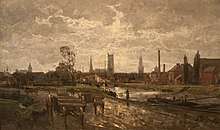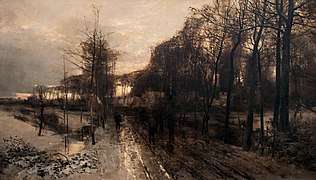Gustave Den Duyts
Gustave Den Duyts (22 October 1850 - 13 February 1897) was a Belgian painter, watercolourist, pastelist, etcher and graphic artist, known for his landscapes.
Biography

He was born in Ghent into an art-loving family, the son of draughtsman Charles Den Duyts. His grandfather Frans Den Duyts was appointed in 1824 as Custodian of Collections of the (newly founded) Ghent University and in 1832 as Custodian of the Collection of Commemorative Medals and Antiquities of the University. Although his artistic talent was evident from a small age he had no lessons and was largely self-taught. Initially opting for a career in industry he decided at the age of 25 to become an artist.
He set up in a small studio in the centre of Ghent with artist Jean Delvin, later the director of the Ghent Academy of Fine Arts, which he occupied until his death in 1897. In 1874 he took part in the Triennial Art Salon of Ghent for the first time.
His graphic work quickly gained attention. His etchings Hoeve in Vlaanderen (Farm in Flanders) and Boerenstulp te Groenendael won him a prize in 1875 in the competition run by the journal "Journal des Beaux-Arts". On the other hand, at the Fifth Exhibition of the Vereniging der Gentsche Kunstoefenaren, where he exhibited together with Jean Delvin, his painting received criticism because of being too modern. Its indefinite forms forced the viewer to squint in order to make it out and this vagueness of definition is now regarded as a forerunner of Flemish impressionism.
Until 1880 Den Duyts continued his studies in the Art Society and Cercle Artistique in Ghent, where he maintained close contact with Jean Delvin and Armand Heins. Together they would become the main members of Ghent's art life in the 1870s.
In 1877 he won a medal at the Paris Salon and in 1881 the Ghent Museum of Fine Arts acquired his Panoramic view of the city of Ghent MSK.
In 1883, Den Duyts contracted pneumonia, which would degenerate into a chronic lung disease until his death. Because he began to feel misunderstood in Ghent, he left in 1887 to settle in Brussels. He nevertheless exhibited at the Triennial Salons of Ghent in both 1892 and 1895. In 1892 he was awarded the honorary diploma of the Dresden Art Society after an international exhibition of watercolors, etchings, pastels and drawings.
He died in Brussels in 1897. He had married in 1895 and his daughter was born after his death.
Work
Much of his work was townscapes or landscapes with a melancholic feeling, often with a setting sun or a rising moon and typically done in autumn or winter. The landscapes are usually bare, skeletal and stylized, betraying the fact that he was a skilled etcher, but never detailed. Human or animal figures are not sharply defined but appear to dissolve into the background.
As a result of his illness, from 1889 he did more work in the studio, such as portraits and still life.
Selected works
 Landscape in the Snow, 1889
Landscape in the Snow, 1889
References
This article is largely based on the equivalent article on Dutch Wikipedia
External links
- Flemish Art Collection
- Biography of Gustaaf Den Duyts on the website of the Liberaal Archief